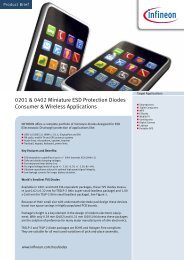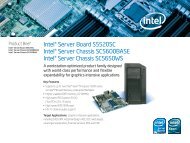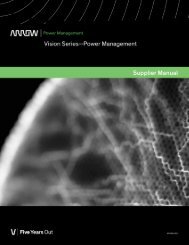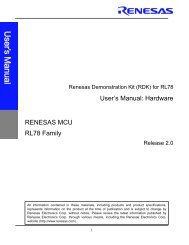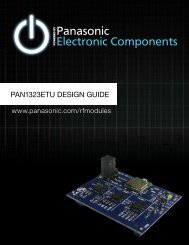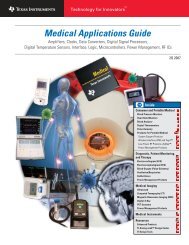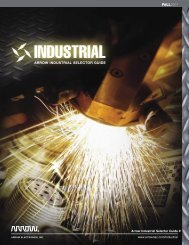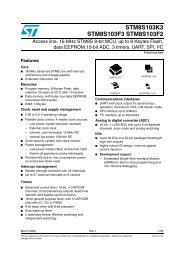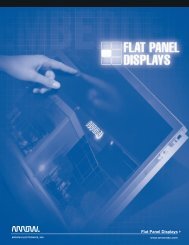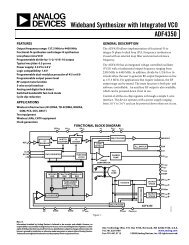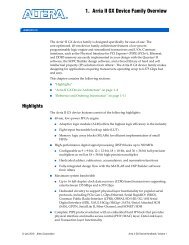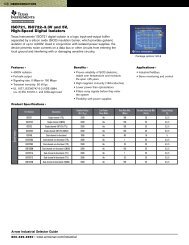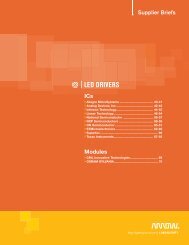Amplifier and Data Converter Selection Guide (Rev. B
Amplifier and Data Converter Selection Guide (Rev. B
Amplifier and Data Converter Selection Guide (Rev. B
- No tags were found...
Create successful ePaper yourself
Turn your PDF publications into a flip-book with our unique Google optimized e-Paper software.
<strong>Amplifier</strong>s37Consumers are enjoying new ways tolisten to music, books <strong>and</strong> news, whiledem<strong>and</strong>ing more flexibility, better quality <strong>and</strong>multifunctional products. There is anever-increasing dem<strong>and</strong> for high-endentertainment for the everyday consumer.The market expects the best listeningexperience from any audio format <strong>and</strong>source, mobile or stationary <strong>and</strong> at acompetitive price.By offering flexible, cost-efficient,end-to-end audio solutions, TI provides OEMs<strong>and</strong> ODMs with faster time-to-market <strong>and</strong>one-stop shopping. TI's complete audiosolutions include best-in-class silicon,systems expertise, software <strong>and</strong> support. Byleveraging the programmability, performanceheadroom <strong>and</strong> design flexibility of TI's leadingDSP <strong>and</strong> analog technologies, customershave the ability to build audio products withmore functionality that offer a true, lifelikesound experience at a lower overallsystem cost.Design ConsiderationsPrimaryOutput power—supply voltage <strong>and</strong> loadimpedance limit the level of output power(i.e., volume) an audio power amp (APA) c<strong>and</strong>rive. Always verify that the desired outputpower is theoretically possible with theequation: where V O is the RMS voltage of theoutput signal <strong>and</strong> R L is the load impedance.P O = V O 2R LOutput configuration—there are two types ofoutput configurations, single-ended (SE) <strong>and</strong>bridge-tied load (BTL). An SE configuration iswhere one end of the load is connected tothe APA <strong>and</strong> the other end of the load isconnected to ground. Used primarily inheadphone applications or where the audiopower amplifier <strong>and</strong> speaker are in differentenclosures. A BTL configuration is whereboth ends of the load are connected to anAPA. This configuration effectively quadruplesthe output power capability of the systemTI’s New Audio Quick Search Tools!<strong>and</strong> is used primarily in applications that arespace constrained <strong>and</strong> where the APA <strong>and</strong>speaker are in the same enclosure.Total Harmonic Distortion + Noise (THD+N)—harmonic distortion is distortion at frequenciesthat are whole number multiples of thetest tone frequency. THD+N is typicallyspecified for rated output power at 1kHz.Values below 0.5 percent to 0.3 percent arenegligible to the untrained ear.<strong>Amplifier</strong> technology (Class-D <strong>and</strong> Class-AB)—Class-D <strong>and</strong> Class-AB are the most commonAPAs in consumer electronics, because oftheir great performance <strong>and</strong> low cost. Class-Damps are very efficient <strong>and</strong> provide thelongest battery life <strong>and</strong> lowest heatdissipation. Class-AB amps offer the greatestselection of features (e.g., digital volumecontrol <strong>and</strong> bass boost).SecondaryDigital volume control—this input changesthe gain of the APA when digital high or lowpulses are applied to the UP <strong>and</strong> DOWN pinsof the device.DC volume control—internal gainsettings that are controlled by DC voltageapplied to the VOLUME pin of the IC.Integrated gain settings—the internal gainsettings are controlled via the input pins,GAIN 0 <strong>and</strong> GAIN 1, of the IC.DEPOP—circuitry internal to the APA. Itminimizes voltage spikes when the APAturns on, off, or transitions in or out ofshutdown mode.Audio <strong>Amplifier</strong>sOn TI’s Audio Home Page, we have added a great new feature! Our Audio Quick SearchTool allows you to easily find the Audio device based on your design specifications. It’seasy to use, just go to www.ti.com/audio <strong>and</strong> select one of the available tools, suchas Audio <strong>Amplifier</strong>s, <strong>Converter</strong>s or CODECs. Select your options <strong>and</strong> the suggesteddevice will take you directly to the product folder.MUX—allows two different audio sources tothe APA that are controlled independently ofthe amplifier configuration.Shutdown—circuitry that places the APA in avery low power consumption st<strong>and</strong>by state.Technical InformationTI APAs are easy to design with, requiring onlya few external components.Power supply capacitors—CV DDminimizes THD by filtering off the lowfrequency noise <strong>and</strong> the high frequencytransients.Input capacitors—in the typical application, C IN ,is required to allow the amplifier to bias theinput signal to the proper dc level for optimumoperation. C IN is usually in the 0.1µF to10µF range for good low-frequency response.Bypass capacitor—C BYPASS controls the startup time <strong>and</strong> helps to reduce the THD.Typically, this capacitor is ten times largerthan the input decoupling capacitors (C IN ).Layout—by respecting basic rules, Class-Damplifiers layout can be made easy.Decoupling caps must be close to the device,the output loop must be small to avoid theuse of a filter <strong>and</strong> the differential inputtraces must be kept together to limit the RFrectification. Analog V DD <strong>and</strong> switching V DDneed to be separated back to supply source.Migration path—APA products are in aconstant evolution moving from Class-ABmono speaker drivers to optimized stereoClass-D amplifiers with advancedfeatures. The latest generation is the mostcost effective for the application.➔Texas Instruments 3Q 2007<strong>Amplifier</strong> <strong>and</strong> <strong>Data</strong> <strong>Converter</strong> <strong>Selection</strong> <strong>Guide</strong>



